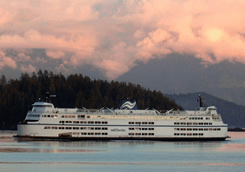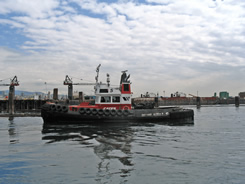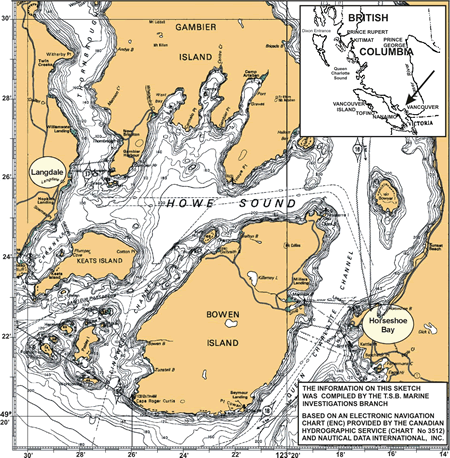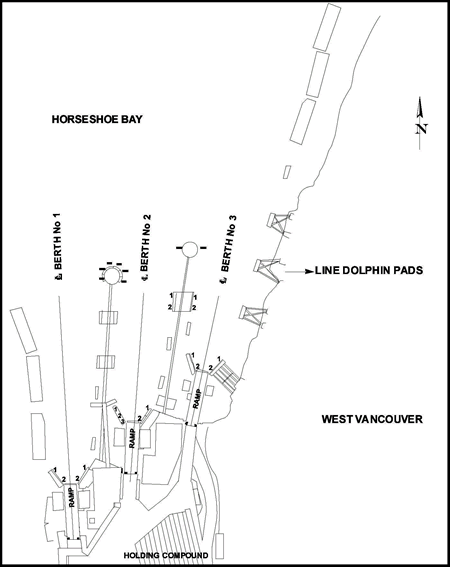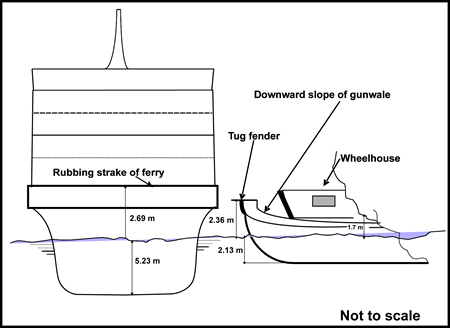Collision
Between the roll-on/roll-off
Vehicle/passenger ferry Queen of Surrey
and assist tug Charles H. Cates V
Horseshoe Bay Terminal, British Columbia
The Transportation Safety Board of Canada (TSB) investigated this occurrence for the purpose of advancing transportation safety. It is not the function of the Board to assign fault or determine civil or criminal liability. This report is not created for use in the context of legal, disciplinary or other proceedings. See Ownership and use of content. Masculine pronouns and position titles may be used to signify all genders to comply with the Canadian Transportation Accident Investigation and Safety Board Act (S.C. 1989, c. 3).
Summary
On the morning of 11 January 2004, while coming alongside its berth at Horseshoe Bay in calm conditions, the Queen of Surrey came in contact heavily with the tug Charles H. Cates V, trapping it between the ferry and a line dolphin pad at the entrance to the dock. The ferry had experienced mechanical problems the day before, and the Charles H. Cates V was standing by to assist in the docking, if and as required. The tug sustained extensive damage, but was able to make its way back to a shipyard in Vancouver Harbour under its own power.
Factual information
Particulars of the vessels
| Name | "QUEEN OF SURREY" | "CHARLES H. CATES V"Footnote 1 |
|---|---|---|
| Official number | 0396048 | 0391885 |
| Port of registry | Vancouver, British Columbia | Vancouver, British Columbia |
| Flag | Canada | Canada |
| Type | Double-ended roll-on/roll-off vehicle/passenger ferry | Harbour docking tug |
| Gross tonsFootnote 2 | 6968.91 | 68.55 |
| Length | 126.9 m | 17.3 m |
| Draught (forward) | 5.72 m | 2.13 m |
| Draught (aft) | 5.72 m | 2.24 m |
| Built | 1981, Vancouver | 1979, Vancouver |
| Propulsion | 2 Mak diesel engines, type 12 M551 AK, 11 860 BHP; 2 Kamewa controllable-pitch propellers | Twin screw, diesel, 1800 BHP |
| Cargo | Passengers and vehicles | N/A |
| Crew members | 28 | 2 |
| Passengers | 59 | None |
| Owners | British Columbia Ferry Corporation,Footnote 3 Victoria | Seaspan International Ltd., Vancouver |
Description of the vessels
Queen of Surrey
The Queen of Surrey is a double-ended roll-on/roll-off vehicle/passenger ferry with a rudder, a single controllable-pitch propeller, and identically equipped wheelhouses at each end. The vessel has three car decks, with the engine room located amidships. The vessel's ends each have a semi-circular deckline in plain view, below which the identical bow and stern sections have considerable flare, fairing the hull into a normal shape at the load waterline.
A steel rubbing strake extends around the vessel's main deck and protrudes approximately 2.7 m at each end and approximately 0.46 m at the sides.
For the purpose of identification, the ends are numbered "1" and "2." This establishes the port and starboard sides of the vessel and the numbering system of the machinery in the engine room. For manoeuvring purposes, the forward end is considered to be the end from which the vessel is being navigated. Only one wheelhouse can be "active" at a time.
Each wheelhouse is equipped with direct pneumatic propulsion controls. The main engines and shafts are uni-directional and the bridge-controlled automation provides direct control of the propeller's rotational speed, as well as its pitch and directional thrust.
The main propulsion system comprises two main diesel engines, four pneumatic clutches, two controllable-pitch propellers and two shaft brakes, and can be used in modes 1 and 2.
Modes of engine propulsion
Used for normal navigation between ports when the vessel is at full speed and in open waters. All control and power transmitted to the aft propeller is by a T-shaped handle on the wheelhouse console. The forward propeller is not used for propulsion; it is "feathered" and its shaft brake applied.
Used for manoeuvring; both propellers are clutched in and their pitches are independently controlled. The forward propeller can either aid or oppose the stern propeller; in the latter case, a braking effect on the vessel is achieved.
The forward propeller is controlled by an L-shaped handle on the wheelhouse console, and the aft propeller is controlled by using the T-shaped handle.
Routine docking/undocking procedures
The Queen of Surrey is engaged on a regular run, ferrying passengers and vehicles between the Langdale and Horseshoe Bay terminals. It is based at Langdale and secures there for the night, with its No. 1 end in the dock. Departures from Langdale, eastbound to Horseshoe Bay, are normally controlled from the No. 2 wheelhouse with only the No. 1 end propeller clutched in for propulsion. Just before arrival at Horseshoe Bay, the No. 2 end propeller is also clutched in, to provide a braking action and slow the vessel down as required. The reverse takes place for westbound return trips to Langdale. Vehicles are therefore driven on from the No. 1 end at Langdale and driven off from the No. 2 end at Horseshoe Bay.
Cates V
The Cates V is a harbour tug with its superstructure located amidships. It is constructed of steel and mainly used to assist deep-sea vessels in docking and undocking. It is powered by two diesel engines driving twin-fixed pitch propellers. The vessel is equipped with a hydraulically operated towing winch located on the after deck.
The wheelhouse is well laid out and affords a near 360° view, with the propulsion controls and steering wheel situated on the main console. A second control console is located directly above the wheelhouse, on the flying bridge.
The bow and the forward flare of the tug are heavily padded with reinforced rubber fenders that protrude approximately 0.22 m from the hull. The gunwale has a pronounced sheer downward from the bow towards the stern on both sides.
History of the voyage
On the night of January 10, while preparing to depart Horseshoe Bay for its last crossing of the day, the Queen of Surrey was unable to engage the No. 1 end clutches. The vessel notified Marine Communications and Traffic Services (MCTS) and also arranged tug assistance for berthing at Langdale.
After the ferry secured at Langdale, with the No. 1 end in the dock, technicians from the control equipment manufacturers and the vessel's engineers worked to identify and rectify the fault. They were unable to complete the work; however, and to continue with the vessel's sailing program the next day, it was decided to use only the No. 2 end propulsion and to use tug assistance as required.
Accordingly, on January 11, the Queen of Surrey departed its berth at Langdale on schedule at 0621 Pacific standard time.Footnote 4 The vessel was manoeuvred out of the dock from the No. 1 wheelhouse, using the No. 2 end propulsion, and swung through 180° in order to have its No.1 end facing forward and towards Horseshoe Bay.
This arrangement made it necessary on arrival at Horseshoe Bay to swing the vessel back through 180° and manoeuvre astern into the No. 3 berth to offload the vehicles through the No. 2 end doors. MCTS was advised of the vessel's departure and its operational parameters and constraints.
On departure from Langdale, the BCFC Shore Superintendent informed the master that a tug arrangement had been made to assist the vessel in berthing at Horseshoe Bay. Contact was established between the tug and the ferry, and the following information exchanged:
- When the ferry arrived off Tyee Point, it would be swung through 180°.
- The bridge crew would then relocate to the No. 2 wheelhouse and change over the controls, which would take time to execute.
- After about 25 minutes, when the ferry was five cables north of Tyee Point, the crew would communicate again.
While en route to Horseshoe Bay, the defect with the No. 1 end clutches was rectified, allowing the vessel to be used in Mode 2 on arrival. However, the master decided to wait until the repair had been approved by an authorized technician who was scheduled to board at Horseshoe Bay.
After rounding Finisterre Island at the north tip of Bowen Island, the Queen of Surrey contacted the Cates V on very high frequency (VHF) channel 72 and informed the skipper that the ferry would be steering on a southerly heading until five cables off Tyee Point. At that time, the crew would swing the vessel 180°, transfer controls to the No. 1 wheelhouse, and dock the vessel under its own power. The tug was requested to position itself north of the berth and well over to the east, close to the cliffs to keep clear, and to provide assistance only if asked to do so.
When the Queen of Surrey approached the desired position north of Tyee Point, the Cates V was in its intended path. The officer of the watch (OOW) on board the ferry called the tug on VHF channel 72 and advised it to stand clear. The ferry then completed its swing to starboard, the navigational crew changed operational control to the No. 1 wheelhouse, and the vessel manoeuvred towards its berth. At this time, the Queen of Surrey's stern doors on the main car deck were also opened in readiness to secure tug lines if required.
When the ferry was approximately four cablesFootnote 5 from the No. 3 berth, the tug called the ferry and again inquired about where it should be positioned. The earlier instructions were repeated: that assistance was not required at this time and that the tug was to stay clear of the ferry's track and be positioned off the ferry's port quarter, close to the cliffs. Seconds later, the ferry was informed that the tug was unable to keep up with the ferry's speed. By now, the ferry had slowed down and this was communicated to the tug with instructions to keep out of the ferry's way.
When the ferry was approximately 20 m away from the dock, the tug skipper called on the VHF. The transmission was difficult to understand as there was static and engine noise in the background. It was understood on board the ferry that he was reporting that the propeller wash from the ferry had pushed the tug between the line dolphin pads located on the shoreline at the entrance to the No. 3 berth, scraping some paintwork. The OOW answered the call while the master's attention was focused on manoeuvring the vessel into its berth.
The Queen of Surrey secured starboard side to the No. 3 berth (see Figure 2) in what appeared to be a smooth docking; no impact was felt either during its approach to the berth or while docking. Upon arrival, and after consulting with the chief engineer, the master decided to retain the services of the tug for the next docking at Horseshoe Bay scheduled for 0900. On contacting the Cates V to relay this request, the tug skipper informed the ferry that the Cates V had sustained damage to its bridge windows and the wheelhouse, and that it would be necessary to order another tug.
Unknown to the bridge team on the Queen of Surrey, the Cates V had been positioned on a westerly heading, between two of the line dolphin pads located on the shoreline. As the ferry drew alongside the berth, its stern swung to port, pushing the tug and trapping it between the ferry's rubbing strake and the line dolphin pads.
It was later determined that the Cates V had sustained considerable damage to its deckhouse, and the vessel was subsequently docked in North Vancouver for repairs. The Queen of Surrey sustained only minor damage and continued on its scheduled crossings. Repairs to the clutches were completed and the ferry resumed using both shafts (Mode 2) at 1340 that same day.
Personnel certification and experience
The crew and officers of both the ferry and tug were appropriately certificated for their positions and the areas of operation of their respective vessels.
The skipper of the tug had worked for the same owners for about 25 years as a skipper, including approximately two years on board the Cates V.
The master on the Queen of Surrey had about seven years of experience as a master with BCFC, including five years on this vessel. The OOW on the bridge at the time of the occurrence had sailed with BCFC since 1974, and had been a deck officer on the Queen of Surrey since 1990.
Damage to vessels
The Queen of Surrey
Steelwork between frames 09 and 12 were buckled, with a minor dent on the rubbing strake in the same area. The bulwarks between the frames were buckled and indentations were visible on the liferaft guides.
The Cates V
The Cates V suffered extensive damage to its superstructure, necessitating a complete rebuilding of its superstructure including all electric wiring, plumbing and fixtures.
Freeboard compatibility between tug and ferry during occurrence
The 0.46 m rubbing strake that protrudes along the sides of the Queen of Surrey's main deck is 7.92 m above the keel. The hull form below this protrusion falls away sharply, sloping inwards towards the centre of the keel. At a mean draft of 5.23 m, the freeboardFootnote 6 of the vessel is 2.69 m.
The Cates V usually operates at a draught of 2.13 m forward and 2.24 m aft. At these draughts, the top of the forward fender arrangement of the vessel is 2.36 m above the waterline. The amidships gunwale is 1.70 m above the waterline, and the stern gunwale is at a height of 1.52 m above the waterline.
As illustrated in Figure 3, the location of the rubbing strake on the Queen of Surrey, the freeboard of the tug, and the sloping of the gunwale render the superstructure of the tug vulnerable to damage while alongside the ferry.
Given the relative heights of the rubbing strake, the tug's freeboard, and the slope of the tug's gunwale, the Cates V can only push the ferry from the side by positioning its bow at right angles to the ferry. The protection provided by the raised gunwale and high fenders at the tug's bow is lost in any other position because of the pronounced downward slope of the gunwale. There was no protocol for the profile of the tug to be matched to that of the vessel it was assigned to assist.
While the tug was manoeuvring into position, it was inadvertently pushed to port and off its heading by the ferry's propeller wash and then pushed further by the ferry's port quarter, which unexpectedly swung out towards the tug. This caused the tug to assume an angle where the rubbing strake of the ferry came into contact with the wheelhouse structure, crushing it and pushing the tug between the ferry and the line dolphin pads.
Findings
Findings as to causes and contributing factors
- The structural incompatibility between the two vessels allowed the ferry to impact upon and severely damage the tug's superstructure.
- While the tug was manoeuvring into position, it was inadvertently pushed to port and off its heading by the ferry's propeller wash and then pushed further by the ferry's port quarter, which unexpectedly swung out towards the tug.
- The bridge team on the ferry was not fully aware of the tug's position.
Finding as to risks
- There was no protocol for the profile of the tug to be matched to that of the vessel it was assigned to assist.
This report concludes the Transportation Safety Board's investigation into this occurrence. Consequently, the Board authorized the release of this report on .
